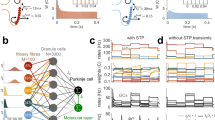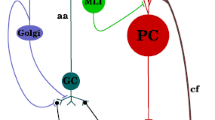Abstract
Dynamics of spike-timing dependent synaptic plasticity are analyzed for excitatory and inhibitory synapses onto cerebellar Purkinje cells. The purpose of this study is to place theoretical constraints on candidate synaptic learning rules that determine the changes in synaptic efficacy due to pairing complex spikes with presynaptic spikes in parallel fibers and inhibitory interneurons. Constraints are derived for the timing between complex spikes and presynaptic spikes, constraints that result from the stability of the learning dynamics of the learning rule. Potential instabilities in the parallel fiber synaptic learning rule are found to be stabilized by synaptic plasticity at inhibitory synapses if the inhibitory learning rules are stable, and conditions for stability of inhibitory plasticity are given. Combining excitatory with inhibitory plasticity provides a mechanism for minimizing the overall synaptic input. Stable learning rules are shown to be able to sculpt simple-spike patterns by regulating the excitability of neurons in the inferior olive that give rise to climbing fibers.
Similar content being viewed by others
References
Abbott LF, Blum KI (1996) Functional significance of long-term potentiation for sequence learning and prediction. Cerebral Cortex 6: 406–416.
Abbott LF, Kepler TB (1990) Model neurons: From Hodgkin-Huxley to Hopfield. In: Garrido L (ed.) Statistical Mechanics of Neural Networks, Springer-Verlag, Berlin, pp. 5–18.
Albus JS (1971) A theory of cerebellar function. Math. Biosci. 10: 25–61.
Barbour B (1993) Synaptic currents evoked in purkinje cells by stimulating individual granule cells. Neuron 11: 759–769.
Barmack NH, Shojaku H (1995) Vestibular and visual climbing fiber signals evoked in the uvula-nodulus of the rabbit cerebellum by natural stimulation. J. Neurophysiol. 74: 2573–2589.
Bell CC, Bodznick D, Montgomery J, Bastian J (1997a) The generation and subtraction of sensory expectations within cerebellum-like structures. Brain. Beh. Evol. 50(Suppl 1): 17–31.
Bell CC, Han V, Sugawara Y, Grant K (1997b) Direction of change in synaptic efficacy following pairing depends on the temporal relation of presynaptic input and postsynaptic spike during pairing. Soc. Neurosci. Abstr. 23: 1840.
Bell CC, Han V, Sugawara Y, Grant K (1997c) Synaptic plasticity in a cerebellum-like structure depends on temporal order. Nature 387: 278–281.
Brunel N, Hakim V, Isope P, Nadal JP, Barbour B (2004) Optimal information storage and the distribution of synaptic weights: perceptron versus purkinje cell. Neuron 43(5): 745–757.
Buonomano DV, Mauk MD (1994) Neural network model of the cerebellum: Temporal discrimination and the timing of motor responses. Neural Comp. 6: 38–55.
Callaway JC, Lasser-Ross N, Ross WN (1995) Ipsps strongly inhibit climbing fiber-activated [Ca2+]\(_i\) increases in the dendrites of cerebellar Purkinje neurons. J. Neurosci. 15: 2777–2787.
Chadderton P, Margrie TW, Hausser M (2004) Integration of quanta in cerebellar granule cells during sensory processing. Nature 428: 856–860.
Chen C, Thompson RF (1995) Temporal specificity of long-term depression in parallel fiber-Purkinje synapses in rat cerebellar slices. Learn. Memory 2: 185–198.
Coesmans M, Weber JT, De Zeeuw CI, Hansel C (2004) Bidirectional parallel fiber plasticity in the cerebellum under climbing fiber control. Neuron 44(4): 691–700.
Crepel F, Jaillard D (1991) Pairing of pre- and postsynaptic activities induces long-term changes in synaptic efficacy in vitro. J. Physiol. 432: 123–141.
de Vries B, Principe J (1992) The gamma model—A new neural network for temporal processing. Neural Netw. 5: 565–576.
DeSchutter E, Bower JM (1994) An active membrane model of the cerebellar Purkinje cell: II. Simulation of synaptic responses. J. Neurophysiol. 71: 401–419.
Doi T, Kuroda S, Michikawa T, Kawato M (2005) Inositol 1,4,5-trisphosphate-dependent Ca2+ threshold dynamics detect spike timing in cerebellar purkinje cells. J. Neurosci. 25(4): 950–961.
Ekerot CF, Jorntell H (2003) Parallel fiber receptive fields: a key to understanding cerebellar operation and learning. Cerebellum 2(2): 101–109.
Ekerot CF, Kano M (1985) Long-term depression of parallel fibre synapses following stimulation of climbing fibres. Brain Res. 342: 357–360.
Fiala JC, Grossberg S, Bullock D (1996) Metabotropic glutamate receptor activation in cerebellar Purkinje cells as substrate for adaptive timing of the classically conditioned eye-blink response. J. Neurosci. 16: 3760–3774.
Gerstner W (1998) Spiking neurons. In: Maass W, Bishop CM (eds.) Pulsed Neural Networks, MIT Press, Cambridge, pp. 3–54.
Gerstner W, Ritz R, Leo Hemmen J (1993) Why spikes? Hebbian learning and retrieval of time-resolved excitation patterns. Biol. Cybern. 69: 503–515.
Gerstner W, Leo Hemmen J (1992) Associative memory in a network of ‘spiking’ neurons. Network 3: 139–164.
Haas JS, Selverston AI, Abarbanel HDI (2004) Spike-timing-dependent plasticity of inhibition in the entorhinal cortex. Soc. Neurosci. Abstr./Online Abstract Viewer. 57: 13.
Han V, Bell CC, Grant K, Sugawara Y (1999) Mormyrid electrosensory lobe in vitro: I. Morphology of cells and circuits. J. Comp. Neurol. 404: 359–374.
Han V, Grant K, Bell CC (2000) Reversible associative depression and nonassociative potentiation at a parallel fiber synapse. Neuron 27: 611–622.
Hansel C, Linden DJ, D’Angelo E (2001) Beyond parallel fiber ltd: the diversity of synaptic and nonsynaptic plasticity in the cerebellum. Nature Neurosci. 4: 467–475.
Hirano T (1991) Differential of pre- and postsynaptic mechanisms for synaptic potentiation and depression between granule cell and a Purkinje cell in rat cerebellar culture. Synapse 7: 321–323.
Houk JC, Alford S (1996) Computational significance of the cerebellar mechanism for synaptic plasticity in Purkinje cells. Beh. Brain Sci. 19: 457–461.
Isope P, Barbour B (2002) Properties of unitary granule cell \({{\to}}\) purkinje cell synapses in adult rat cerebellar slices. J. Neurosci. 22(22): 9668–9678.
Isope P, Dieudonne S, Barbour B (2002) Temporal organization of activity in the cerebellar cortex: a manifesto for synchrony. Ann. NY Acad. Sci. 978: 164–174.
Ito M (1989) Long-term depression. Ann. Rev. Neurosci. 12: 85–102.
Ito M (1990) Long-term depression in the cerebellum. Seminars Neurosci. 2: 381–390.
Ito M, Sakurai M, Tongroach P (1982) Climbing fibre induced depression of both mossy fiber responsiveness and glutamate sensitivity of cerebellar Purkinje cells. J. Physiol. (London) 5: 275–289.
Jack JJB, Noble D, Tsien RW (1975) Electric Current Flow in Excitable Cells. Clarendon Press, Oxford.
Jörntell H, Ekerot CF (2002) Reciprocal bidirectional plasticity of parallel fiber receptive fields in cerebellar purkinje cells and their afferent interneurons. Neuron 34(5): 797–806.
Kano M, Rexhausen U, Dreessen J, Konnerth A (1992) Synaptic excitation produces a long-lasting rebound potentiation of inhibitory synaptic signals in cerebellar Purkinje cells. Nature 356: 601–604.
Karachot L, Kado RT, Ito M (1994) Stimulus parameters for induction of long-term depression in in vitro rat Purkinje cells. Neurosci. Res. 21: 161–168.
Lev-Ram V, Makings LR, Keitz PF, Kao JPY, Tsien RY (1995) Long-term depression in cerebellar Purkinje neurons results from coincidence of nitric oxide and depolarization-induced Ca2+ transients. Neuron 15: 407–415.
Lev-Ram V, Wong ST, Storm DR, Tsien RY (2002) A new form of cerebellar long-term potentiation is postsynaptic and depends on nitric oxide but not camp. Proc. Natl. Acad. Sci. USA 99(12): 8389–8393.
Levine MW (1991) The distribution of the intervals between neural impulses in the maintained discharges of retinal ganglion cells. Biol. Cybern. 65: 459–467.
Linden DJ, Dickinson MH, Smeyne M, Connor JA (1991) A long term depression of ampa currents currents in cultured cerebellar Purkinje neurons. Neuron 7: 81–89.
Linden DJ, Connor JA (1993) Cellular mechanisms of long-term depression in the cerebellum. Curr. Op. Neurobiol. 3: 401–406.
Llinás R, Sugimori M (1980) Electrophysiological properties of in vitro Purkinje cell dendrites in mammalian cerebellar slices. J. Physiol. (London) 395: 197–213.
Llinás R (1975) The cortex of the cerebellum. Sci. Am. 232: 56–71.
Maex R, DeSchutter E (1998) Synchronization of golgi and granule cell firing in a detailed network model of the cerebellar granule cell layer. J. Neurophysiol. 80: 2521–2537.
Marr D (1969) A theory of cerebellar cortex. J. Physiol. 202: 437–470.
Mauk MD (1997) Roles of cerebellar cortex and nuclei in motor learning: contradictions or clues? Neuron 18: 343–346.
Medina JF, Mauk MD (2000) Computer simulation of cerebellar information processing. Nat. Neurosci. 3(Suppl): 1205–1211.
Miyata M, Finch EA, Khiroug L, Hashimoto K, Hayasaka S, Oda SI, Inouye M, Takagishi Y, Augustine GJ, Kano M (2000) Local calcium release in dendritic spines required for long-term synaptic depression. Neuron 28(1): 233–244.
Mohr C, Roberts PD, Bell CC (2002) Cells of the mormyrid electrosensory lobe: I. Responses to the electric organ corollary discharge and to electrosensory stimuli. J. Neurophysiol. 90: 1193–1210.
Nagano T, Ohmi O (1978) Plausible function of Golgi cells in the cerebellar cortex. Biol Cybern. 29: 75–82.
Neale SA, Garthwaite J, Batchelor AM (2001) mglu1 receptors mediate a post-tetanic depression at parallel fibre-purkinje cell synapses in rat cerebellum. Eur. J. Neurosci. 14(8): 1313–1319.
Pellionisz A, Szentágothai J (1973) Dynamic single unit simulation of a realistic cerebellar network model. Brain Res. 49: 83–99.
Roberts PD (1997) Stochastic recruitment in parallel fiber activity patterns. Beh. Brain Sci. 20: 263–264.
Roberts PD (2000a) Dynamics of temporal learning rules. Phys. Rev. E 62: 4077–4082.
Roberts PD (2000b). Electrosensory response mechanisms in mormyrid electric fish. Neurocomputing 32–33: 243–248.
Roberts PD (2000c) Modeling inhibitory plasticity in the electrosensory system. J. Neurophysiol. 84: 2035–2047.
Roberts PD (2004) Recurrent biological neural networks: The weak and noisy limit. Phys. Rev. E 69: 031910.
Roberts PD (2005) Recurrent neural network generates a basis for sensory image cancellation. Neurocomputing 65–66: 237–242.
Roberts PD, Bell CC (2000) Computational consequences of temporally asymmetric learning rules: II. Sensory image cancellation. J. Comput. Neurosci. 9: 67–83.
Roberts PD, Bell CC (2002) Spike timing dependent synaptic plasticity in biological systems. Biol. Cybern. 87: 392–403.
Ruigrok TJH, Voogd J (1995) Cerebellar influence on olivary excitability in the cat. Euro. J. Neurosci. 7: 679–693.
Rumsey CC, Abbott LF (2004) Equalization of synaptic efficacy by activity- and timing-dependent synaptic plasticity. J. Neurophysiol. 91: 2273–2280.
Sakurai M (1989) Depression and potentiation of parallel fiber-Purkinje cell transmission in in vitro cerebellar slices. In: Strata P (ed.) The Olivocerebellar System in Motor Control, Springer-Verlag, Berlin, pp. 221–230.
Schreurs BG, Alkon DL (1993) Rabbit cerebellar slice analysis of long-term depression and its role in classical conditioning. Brain Res. 631: 235–240.
Schreurs BG, Oh MM, Alkon DL (1996) Pairing-specific long-term depression of Purkinje cell excitatory postsynaptic potentials results from a classical conditioning procedure in the rabbit cerebellar slice. J. Neurophysiol. 75: 1051–1060.
Schweighofer N, Doya K, Lay F (2001) Unsupervised learning of granule cell sparse codes enhances cerebellar adaptive control. Neuroscience 103: 35–50.
Simpson JI, Hulscher HC, Sabel-Goedknegt E, Ruigrok TJ (2005) Between in and out: linking morphology and physiology of cerebellar cortical interneurons. Prog. Brain Res. 148: 329–340.
Stein RB (1967) The frequency of nerve action potentials generated by applied currents. Proc. R. Soc. B (London) 167: 613–635.
Steuber V, Willshaw D (2004) A biophysical model of synaptic delay learning and temporal pattern recognition in a cerebellar purkinje cell. J. Comput. Neurosci 17(2): 149–164.
Traub RD, Wong RKS, Miles R, Michelson H (1991) A model of a CA3 hippocampal pyramidal neuron incorporating voltage-clamp data on intrinsic conductances. J. Neurophysiol. 66: 635–650.
Vos BP, Maex R, Volny-Luraghi A, DeSchutter E (1999) Parallel fibers synchronize spontaneous activity in cerebellar golgi cells. J. Neurosci. 19: 464–476.
Wang SS, Denk W, Hausser M (2000) Coincidence detection in single dendritic spines mediated by calcium release. Nat. Neurosci. 3(12): 1266–1273.
Williams A, Roberts PD, Leen TK (2003) Stability of negative-image equilibria in spike-timing-dependent plasticity. Phys. Rev. E 68(2/1): 021923.
Woodin MA, Ganguly K, Poo (2003) Coincident pre- and postsynaptic activity modifies GABAergic synapses by postsynaptic changes in Cl- transporter activity. Neuron 39: 807–820.
Author information
Authors and Affiliations
Corresponding author
Additional information
Action Editor:
Nicolas Brunel
Rights and permissions
About this article
Cite this article
Roberts, P.D. Stability of complex spike timing-dependent plasticity in cerebellar learning. J Comput Neurosci 22, 283–296 (2007). https://doi.org/10.1007/s10827-006-0012-8
Received:
Revised:
Accepted:
Published:
Issue Date:
DOI: https://doi.org/10.1007/s10827-006-0012-8




